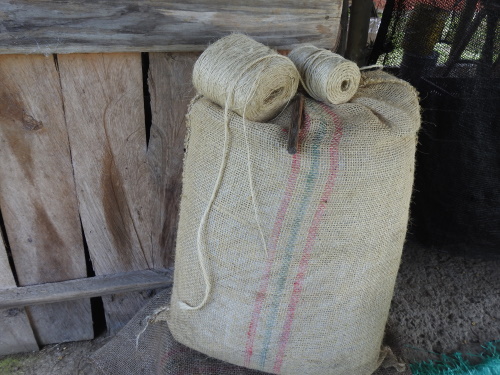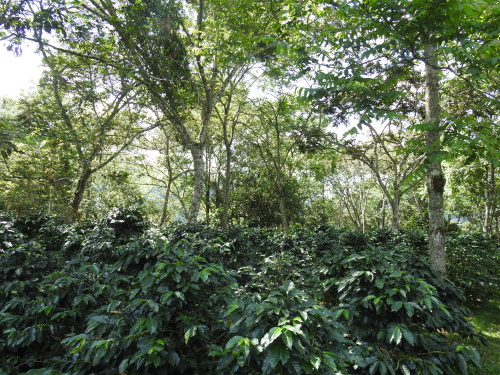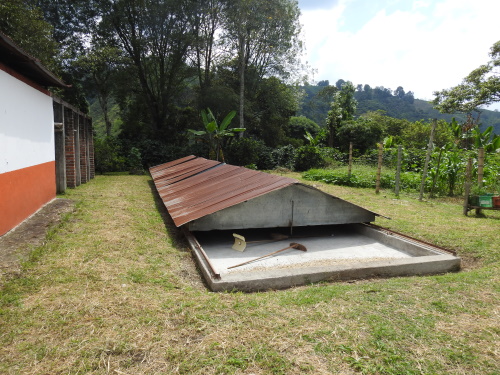Blog WHS Visits
WHS #729: Coffee Cultural Landscape
It is really telling that the 5 reviews of the Coffee Cultural Landscape so far focused fully or at least partly on the boundaries of this WHS. It reminded me of a WH travelers group T-shirt suggestion (made by Samuel) that promoted the slogan “Are we in the core zone yet?”. Well, I will focus on the coffee production instead as the ‘tick’ should consist of having seen/experienced the OUV in addition to setting foot in a certain area.
What makes Colombian coffee farming (especially in and around the selected areas) different from others? Most farms are small scale family operations using manual labour, shade grown coffee is the traditional system and there is a strong community focus on coffee production in all aspects of life. I decided to look for these characteristics south of Salento, in an area called Palestina. Here there are a number of coffee farms that open to visitors. The biggest (which even needs pre-booking) is El Ocaso, one of the most popular among English-speaking tourists is Don Elias, but I went for the more low-key El Recuerdo. I hiked there in just over an hour from Salento on a pleasant path, where the coffee plants that had been absent so far on my travels in this region became more and more prominent in the surrounding landscape.
El Recuerdo is a small, organic farm that applies polyculture. Besides coffee, they grow fruits and herbs for their own use. They adhere to the principles of the Rainforest Alliance for sustainable farming. I was assigned a young biologist as a guide and we could start the tour right away. They usually see only a handful of tourists a day.
The tour started with an explanation how coffee growing came to the region. This was relatively late into the whole expansion of coffee production around the world: Jesuits brought it with them from Venezuela in 1732. First to the region around Medellin and in the 19th century it spread further around Colombia due to internal migrations. We then moved on to have a look at the herbal garden – it even holds one original Colombian coca plant (“It’s not the plant’s fault what happened…”).
In contrast to many other farms in the region, this one still produces shade grown coffee. This essentially means that the coffee plants are planted within a thin forest of trees. The trees provide shade, but also fertilize the ground through their leaves and attract insects and birds. At other places the trees have all been cleared to increase productivity (more coffee plants per square meter), a practice that attracted a sour remark from IUCN (“They can’t be included, can they?”). Among the plants in the forest of El Recuerdo are various kinds of citrus fruits. And the guide showed me a beautifully woven hummingbird nest with 2 eggs.
In general in Colombia, the coffee farmers only produce dried coffee beans which are then sold to the cooperation which in its turn sells it often to roasters abroad. This farm cut out the middlemen, uses a private roaster near the town of Armenia and sells its coffee in its own shop at the farm and in shops in nearby towns.
I had been to a small coffee farm once before, that was near Matagalpa in Nicaragua. The process used there is exactly the same as far as I can see as a non-expert. The farm used polyculture as well. There I also enjoyed the bustle of a coffee market town, with sacks of coffee beans being transported in various manners. They do also have larger factories (processing plants) there. This transport & trade aspect I missed here in the Armenia/Salento region, but it must be said that I arrived outside of the coffee harvesting season which takes place yearly in May/June and October.
Els - 26 January 2020
Comments
Solivagant 28 January 2020
Just to clarify that further investigation confirms that the Coffee Finca El Recuerdo visited by Els is outside both the core and buffer zones of the CCL (as are all others in the Salento area). This of course in no way detracts from the value of Els’s visit and her observations both for her personally and for the rest of us. In fact, in my mind, it re-emphasises the “weakness” of this entire WHS as inscribed. If there are examples which are just as good (or even better?) outside the inscribed site then what is the inscription achieving?
Some might say that the fincas inside the inscribed area are going to be subject to stricter control in the future and are therefore being “preserved” by inscription in a way which those beyond are not. I very much doubt this and would foresee an increase in inscribed areas being “technified” in coming years since such development has actually been cemented within the current OUV (Adaptation process…. which has continued to this day” – UNESCO) ! Indeed it could be that many of the best examples of small scale, family run, eco-friendly coffee production could finish up being the specialists operating outside the inscribed area!!
Another argument could be that the inscribed area is only supposed to be “Representative” and that non inscription doesn’t imply “non value”. (“An exceptional example of a sustainable and productive cultural landscape that is unique and representative of a tradition that is a strong symbol for coffee growing areas worldwide”- UNESCO) This might have more weight if the inscription had limited itself to the “best of the best” - but it clearly hasn’t. This is particularly true of the urban areas – “mainly situated on the relatively flat tops of hills above sloping coffee fields, are characterized by the architecture of the Antioquian colonization with Spanish influence” and containing “very few contemporary incongruous additions to its traditional architectural and landscape patterns, and no substantial modifications to the small towns located in the property as well as in the buffer zone” - (UNESCO). Not true – viz Chinchina and Neira have been included with no (Chinchina – all concrete buildings, fly-overs and factories!) or very little (Neira) “Traditional architecture”. Whilst Salento has been excluded! Whatever one might think of what that town has become in terms of being a tourist honey pot, it at least contains a significant number of such buildings.
Els Slots 27 January 2020
No, I did not ask about that and it did not come up during the 2 hour tour.
Purely speculating here, but what may have been a factor is the (non-)alignment of these Salento farms with the 'National Federation of Coffee Growers of Colombia'. That Federation is a big player in the marketing of Colombian coffee and also worked on the nomination file. The specific farm that I visited did not agree with many of the 'improvements' suggested by the federation.
Another possible factor may be that the Salento coffee farms are more 'show farms'. They do still produce coffee (most of them), but not for the generic Colombian export. To what extent that already was the case in 2010 when the nomination file was written I do not know, the fulfillment of the tourist potential of Salento is fairly recent.
Solivagant 27 January 2020
During your finca visit were you able to establish anything more about why the boundaries of the Nominated site were set as they were? It would seem from the infamous map, that El Recuerdo was inside the Buffer zone just to the east of the Rio Quindio (though it might have been inside the small portion of Salento Municipaility which is inside the core Zone) - correct? As you say – it would seem to possess exactly the same attributes which allowed other fincas to be included in the Core Zone (“ small scale family operations using manual labour, shade grown coffee … and … a strong community focus on coffee production in all aspects of life”). Indeed one would have thought that nearby Salento itself and the fincas in between would have been a “shoo in” for nomination. Did the Finca care? Was it politics? Did the area not want the potential restrictions of inclusion? Did they claim inclusion from simply being in the Buffer Zone?
Establishing the boundaries of this (or any other) WHS isn’t of course just a matter of getting a tick for entering them - it is part of understanding the site itself. You correctly highlight the attributes of small scale, shade grown etc – but, as per my previous review, quite large parts of the WHS do not demonstrate these attributes at all and the nomination makes a virtue of them not doing so (“Technification”)!!


